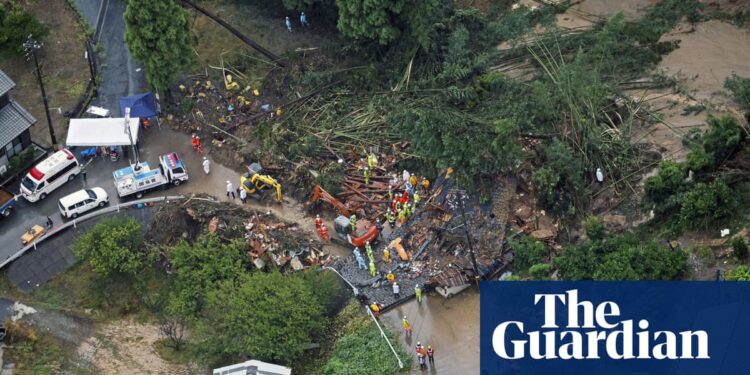Japan’s strongest typhoon of the year has made landfall in the country’s south-west, bringing torrential rain and winds of up to 252 km/h (157 mph), strong enough to destroy homes.
The meteorological agency said Typhoon Shanshan, referred to in Japan as Typhoon No 10, made landfall on the island of Kyushu at around 8am. The power company said 254,610 houses were already without electricity.
The meteorological agency predicted 1,100mm (43in) of precipitation in southern Kyushu in the 48 hours to Friday morning, around half the annual average for the area, which comprises Kagoshima and Miyazaki prefectures.
Authorities issued a rare special typhoon warning for most parts of Kagoshima, a prefecture in southern Kyushu. Residents in at-risk areas have been urged to remain on high alert, with transport operators and airlines cancelling trains and flights.
The potential for major damage is high given Shanshan’s sluggish speed. The storm is moving northwards at just 15km/h, the meteorological agency said.
There have already been reports of deaths in landslides – a major hazard in mountainous areas – while tens of thousands of people have been advised to evacuate.
“Typhoon Shanshan is expected to approach southern Kyushu with extremely strong force through Thursday,” chief cabinet secretary Yoshimasa Hayashi told reporters earlier. “It is expected that violent winds, high waves and storm surges at levels that many people have never experienced before may occur.”
The approach of the storm prompted automaker Toyota to suspend production at all 14 of its factories. Other major car manufacturers have followed suit, according to the Kyodo news agency.
Three members of a family died after a landslide buried a house in the central city of Gamagori, Kyodo reported early on Thursday, citing local government officials.
The victims included a couple in their 70s and a son in his 30s, while two adult daughters in their 40s were injured, Kyodo added.
The agency also issued its highest “special warning” for violent storms, waves and high tides in parts of the Kagoshima region, with authorities there advising 56,000 people to evacuate.
Video footage on public broadcaster NHK TV showed roof tiles being blown off houses, broken windows and felled trees.
“Our carport roof was blown away in its entirety. I wasn’t at home when it happened, but my kids say they felt the shaking so strong they thought an earthquake happened,” one resident in Miyazaki told NHK. “I was surprised. It was completely beyond our imagination.”
The warnings indicate the “possibility that a major disaster prompted by [the typhoon] is extremely high,” Satoshi Sugimoto, chief forecaster of the meteorological agency, told a news conference.
Japan Airlines cancelled 172 domestic flights and six international flights scheduled for Wednesday and Thursday, while ANA scrapped 219 domestic flights and four international ones across Wednesday, Thursday and Friday.
The cancellations affected about 25,000 people.
Kyushu Railway said it would suspend some bullet train services between Kumamoto and Kagoshima Chuo from Wednesday night and warned of further possible disruption. Trains between Tokyo and Fukuoka, the most populous city on Kyushu, may also be cancelled depending on weather conditions this week, other operators said.
Shanshan comes in the wake of Typhoon Ampil, which disrupted hundreds of flights and trains this month. Despite dumping heavy rain, it caused only minor injuries and damage.
Ampil came days after Tropical Storm Maria brought record rains to northern areas.
Japan has issued special typhoon warnings only three times in the past. The first came in July 2014, when a strong typhoon brought record-breaking waves to the southern prefecture of Okinawa before moving north, killing three people in landslides in Nagano prefecture.
In October 2016, authorities issued a similar warning for Okinawa’s main island. The typhoon moved north over the sea west of the southernmost main island of Kyushu.
The most recent special typhoon warning came in September 2022 – the first time the warning had been issued outside Okinawa prefecture, according to public broadcaster NHK.
Like the typhoon that made landfall in southwestern Japan on Thursday morning, the storm moved slowly, giving it time to cause extensive damage to homes. Five people died in the disaster.
Typhoons in the region have been forming closer to coastlines, intensifying more rapidly and lasting longer over land due to the climate crisis, according to a study released last month.
Human-caused climate breakdown has increased the occurrence of the most intense and destructive tropical cyclones (though the overall number per year has not changed globally). This is because warming oceans provide more energy, producing stronger storms.
Extreme rainfall from tropical cyclones has increased substantially, as warmer air holds more water vapour. For example, the amount of rainfall produced by Hurricane Harvey in Texas in 2017 would have been all but impossible without the record-warm ocean water in the Gulf of Mexico.
Coastal storm surges are also higher and more damaging due to the sea level rise driven by climate breakdown. For example, the devastating storm surge from Typhoon Haiyan, which hit the Philippines in 2013, was about 20% higher due to human-caused climate breakdown.
With Agence France-Presse







